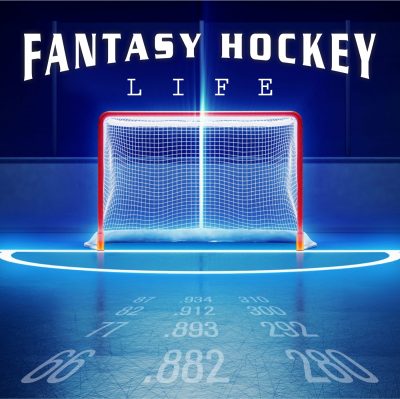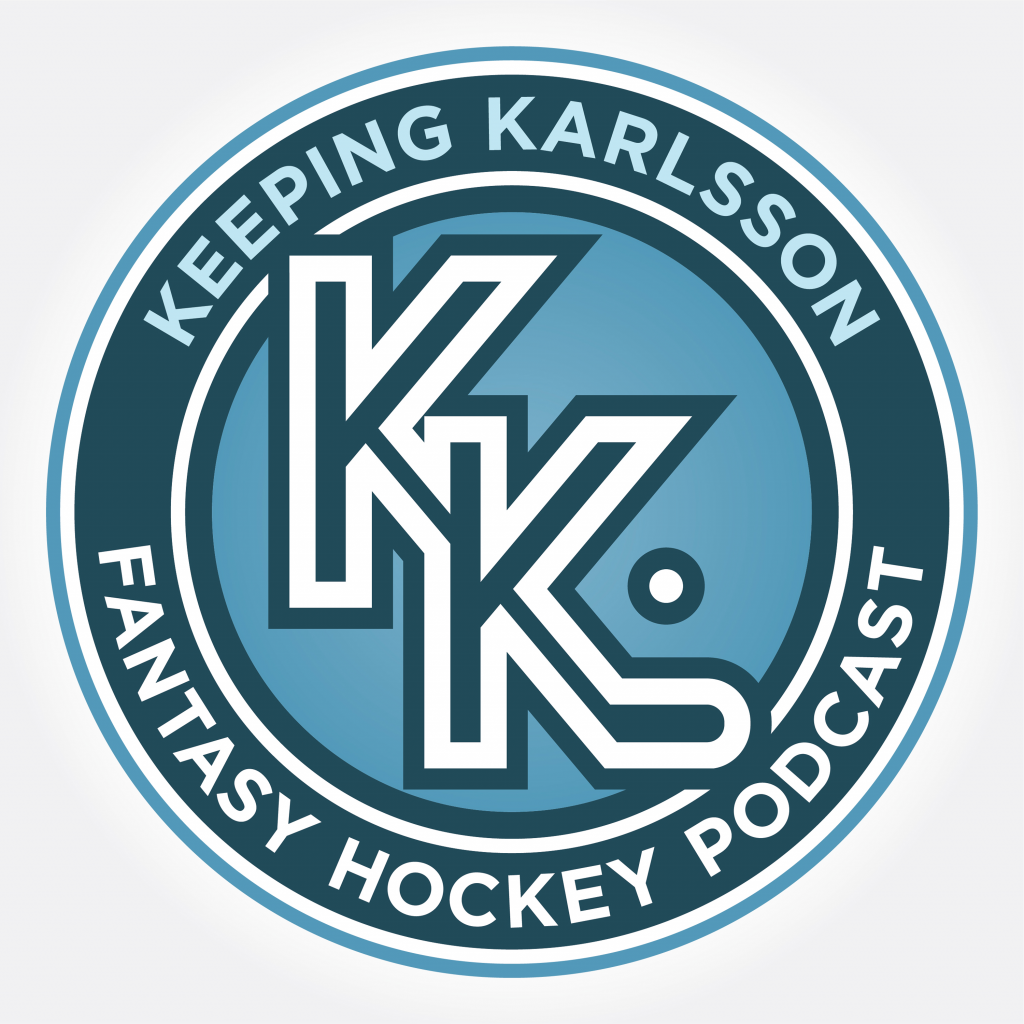Every Sunday, we share 21 Fantasy Rambles from our writers at DobberHockey. These thoughts are curated from the past week’s 'Daily Ramblings'.
Writers/Editors: Ian Gooding, Michael Clifford, Alexander MacLean, Brennan Des, and Dobber
—
The 19th annual Fantasy Prospects Report is now available!
Pick up yours at Dobber Sports so that you can get ahead with your offseason keeper league decisions.
—
1. In news from Tuesday, we had Lane Hutson claiming the Calder Trophy, in what was a stacked year for rookies. Hutson finished the year with 66 points in 82 games, playing almost 23 minutes a night, and driving play exceptionally well, albeit in a bit of a sheltered role. Maybe now NHL teams will focus a little less on size, with Hutson, Michkov, and Wolf each coming in below average in height for their positions, and all finishing as top-five rookies this past year.
And yet, we’re still going to see teams reach for size in the draft three weeks from now… (june11)
2. Moving onto some more general fantasy discussion, today we’re going to look at projecting player movement in the offseason. It’s difficult in many cases, but in some cases it’s worthwhile doing anyways to try and get ahead of player value fluctuations. With goaltenders, it’s a lot easier to find some of those incoming changes, due to the small number of goalies per team, making it easier to project how a team might approach filling out their roster for next year.
On top of that, it’s very rare that we see many goalies traded. Last season felt like an outlier with Scott Wedgewood, Mackenzie Blackwood, Vitek Vanecek, Alexandar Georgiev, and a few other third-stringers traded after we already saw Logan Thompson and Darcy Kuemper shopped around in the summer.
This year I expect things to be a little bit more settled, in part due to most of the big-name starters being locked into contracts that span at least one more season, and a large majority of them currently aged 32 or younger (i.e. right in a goalie’s prime window). (june11)
3. I’m going to run through the teams in reverse alphabetical order, partially just to change up the order from usual, but also because it’s much easier to start with Connor Hellebuyck than whatever is going to happen with John Gibson (so yes, he’s all the way at the end of the article… but maybe not the last team):
Winnipeg Jets
Spring 2025 Tandem: Connor Hellebuyck, Eric Comrie
Projected Fall 2025 Tandem: Connor Hellebuyck, Eric Comrie
Hellebuyck still has six years left on his $8.5 million deal, and it has looked like an absolute steal through the first two years. He’s 32 now and seems to have left behind his early-career inconsistencies. Eric Comrie is in a great spot to spell Hellebuyck when needed, and I do expect the Jets to rest Hellebuyck more this year in anticipation of the post-season, meaning Comrie could start 25-30 games instead of last year’s 20 total appearances. (june11)
4. Washington Capitals
Spring 2025 Tandem: Logan Thompson, Charlie Lindgren
Projected Fall 2025 Tandem: Logan Thompson, Charlie Lindgren
Washington should be running back their same duo from their top-of-the-table finish in the Eastern Conference, but the difference is that this year instead of playing less than $2 million for the pair, they’re going to cost the Capitals almost $9 million against the cap. Even with the huge jump in pay, they should still be worth the money. (june11)
5. Vegas Golden Knights
Spring 2025 Tandem: Adin Hill, Ilya Samsonov
Projected Fall 2025 Tandem: Adin Hill, Jake Allen, Akira Schmid
Hill was excellent in his 50 games this past season, while Samsonov struggled at times. Brining in Allen gives Vegas a more reliable second option so that Hill doesn’t have to tire himself out, or rush back in the case of an injury. The other option for Vegas, with them always looking to pinch every penny to bring in new star players, would be to give last year’s third-stringer Schmid an opportunity on a very cheap contract to start 20-25 games for the team after he put up solid numbers between the AHL and NHL this past year. This one depends on how successful they are in spending on skaters. (june11)
[Follow the link for more…]6. Washington Capitals forward TJ Oshie announced his retirement on Monday. The 38-year-old Oshie missed the entire 2024-25 season with a nagging back injury, and had missed 92 games over the three seasons before that, so this was just a player who had seen his physical health decline to the point where returning to the NHL was not realistic.
Oshie finishes his career with 302 goals and 393 assists in 1010 regular season games, 34 goals and 35 assists in 106 playoff games, a Stanley Cup ring from 2018, as well as being a member of Team USA’s World Junior, World Championship, World Cup, and Olympic rosters at various points.
From a fantasy perspective, Oshie was often in the very good-not-great category, reaching both the 30-goal (33 goals in 2016-17) and the 60-point (60 in 2013-14) plateaus just once each. However, he averaged 26 goals, 33 assists, 18 power-play points, 171 shots, 99 hits, and 47 blocks every 82 games from 2013-2021. Those are solid across-the-board contributions for a decade and reflect him being a similar type of player on the ice. All the best to him and his family in retirement. (june10)
7. I thought we could discuss players who elevated their shot totals or power-play production, achieving elite status in that respective category. Let’s get right into it
Shots on Goal
Macklin Celebrini
2024-25: 3.37 shots/game (Rank: 13th overall)
2023-24: Not Ranked
Celebrini racking up shots in his debut NHL campaign shouldn’t come as a huge surprise. After all, he placed third in shots during his final NCAA season, posting 179 over 38 games. Most 18-year-olds aren’t trusted with nearly 20 minutes of action a night, but Celebrini’s elite talent demanded a high-volume of opportunity, and he used that time to put pucks on net. On the power-play, Celebrini shared the ice with Tyler Toffoli, who’s been a shooting threat throughout his NHL career. Still, it was Celebrini who led the team in both shot attempts and actual shots with the man advantage. As San Jose’s primary trigger man, Celebrini brings great value to the shots category in fantasy leagues. (june9)
8. Matt Boldy
2024-25: 3.30 s/g (14th overall)
2023-24: 3.03 s/g (41st overall)
An increase of 0.27 shots per game may seem insignificant, but over the course of a season that’s 22 extra shots, which could very well be the difference between sweet victory and bitter defeat in fantasy leagues. One of the things that helped Boldy shoot the puck more this year was more ice time. He saw 20 minutes and 17 seconds per game, up from 18:55 last year. Now, you may be wondering if Boldy shot the puck more often because superstar teammate Kirill Kaprizov wasn’t in the lineup for half of the season. It’s a fair question to ask, but my answer would be no. Boldy played 41 games with Kaprizov and 41 games without Kaprizov this season, ending up with five more shots in the latter sample. Sure, it’s a difference, but not significant enough to cause concern that a healthy Kaprizov will hinder Boldy’s shot rate next year. Boldy has come into his own as a star player and high-volume shooter in this league. He deserves to skate 20 minutes a night again next year, and doing so would help him match or improve on this year’s shot rate. (june9)
2024-25: 3.10 s/g (18th overall)
2023-24: 2.06 s/g (184th overall)
Increased opportunity was key to Dorofeyev’s shooting binge this season. Last year, he saw just 13 minutes of ice time a night, holding a measly 20% share of Vegas’ time with the man advantage. This year, he averaged 16 and a half minutes a night and saw 60% of Vegas’ power-play time. Dorofeyev led the Golden Knights in power-play shots, illustrating his skillset as a shooter. Being trusted as the trigger man on a unit that also features Jack Eichel is no small feat. (In fairness, Eichel was just one PP shot behind Dorofeyev despite playing five fewer games, but the point still stands). While top unit PP time was undeniably beneficial for Doro, he wasn’t overly reliant on the man advantage to boost his shot totals. From early December to early January, he was mostly relegated to the second unit and tallied just six shots on the power-play over 17 games. Although the power-play wasn’t a great source for shots during this stretch, he still managed a respectable 2.76 shots per game because he’s not afraid to shoot the puck, even at even strength. That willingness to shoot is reinforced by iFF, a stat that measures all unblocked shot attempts – goals, shots on net, and misses. Not only did Dorofeyev lead all Golden Knights in unblocked shot attempts at even strength, he ranked 20th across the league (via Natural Stat Trick). The 24-year-old forward is solidifying his identity in the NHL, and it seems that putting pucks on net is in his DNA. (june9)
10. Power Play Points
2024-25: 37 Power Play Points (T3 overall)
2023-24: 16 PPP (113th overall)
There were a few key ingredients to Raymond’s recipe for power-play success this year. For starters, he saw 67% of Detroit’s total time with the man advantage, which is a significant jump from the 50% he saw last year. One might say that Raymond actually enjoyed decent power-play opportunity in his first two NHL campaigns, where he saw at 55-60% of Detroit’s total PP time. There are two main reasons why the reps he saw on PP1 back then can’t be compared to what he saw this past season: 1) he’s made great strides and is a much better player at 23 than he was at 20 or 21 and 2) his supporting cast on the power play is better now than it was back then. To better illustrate that second point, let’s review the Red Wings that saw top-unit time with Raymond in those early years. In Raymond’s rookie campaign, it was Tyler Bertuzzi and Robby Fabbri. In his sophomore year, those two were replaced by David Perron and Alex Chiasson. This year, it was Patrick Kane and Alex DeBrincat. I don’t think it’s outlandish to suggest that Kane and DeBrincat represent a sizeable upgrade on the PP compared to past duos.
With a now elite Raymond skating alongside four offensive dynamos, it’s no surprise that Detroit posted a franchise-best PP success rate this season at a whopping 27%. A lot of that top-unit offense ran through Raymond as he registered a point on 72.6% of PP goals scored while he was on the ice. Now, that’s higher than the 60% PPIPP Raymond posted in his previous three years, and for some players (see Strome below), it might be a red flag to suddenly start picking up more points than usual with the man advantage. However, that isn’t as much of a concern here because Raymond is still young, so it’s fair to view this season as his new normal now that he’s develop into a better player, instead of as an anomaly had he been older and this came out of nowhere. To further dispel concerns about an inflated PPIPP, consider that Detroit’s power-play configuration this year was different than previous years. That creates different dynamics, making it plausible that Raymond is more of a play driver with this group than he was before. If Kane re-signs and Detroit can get the band back together next year, I think a healthy Raymond hits 30 PPPs again. (june9)
11. Martin Necas
2024-25: 37 PPP (T3 overall)
2023-24: 13 PPP (137th overall)
I touched on Necas’ power-play contributions when talking about Carolina’s PP in last Sunday’s Ramblings, so I won’t spend too much time on him here.
We saw a glimpse of Necas’ power-play prowess in 2022-23, when he racked up 26 PPPs thanks to consistent top-unit time for the first time in his career. For some strange reason, Carolina relegated him to the second unit the next season (last year), which is why he only managed 13 PPPs in 2023-24. He returned to the top unit this season and showed everyone that he’s way too good for PP2. Necas racked up 22 PPPs in 49 games for Carolina, and then carried that success into Colorado, posting 15 points with the man advantage through 30 games after he was traded. The Avs’ PP success rate went from 20.4% before the Necas trade, to a league leading 32.2% afterwards. Of course, Colorado dealt with a bunch of injuries in the first half which left PP1 in flux, so it wouldn’t be fair to attribute that increase to Necas alone, but it’s reassuring to see that he didn’t mess with any MacKinnon or Makar mojo. If he remains in Colorado all year, he should be able to crack 30 PPPs again. (june9)
12. Dylan Strome
2024-25: 34 PPP (T7 overall)
2023-24: 22 PPP (T57 overall)
A minor increase in power-play success rate for Washington – from 20.6% to 23.5% – but a significant increase in power-play production for Strome. What gives? Well for starters, Strome registered a point on 83% of the PP goals scored while he was on the ice this season. In recent years, that number hovered between 50% and 70%, so this was certainly a sizable increase and some, myself included, might even call it an anomaly. It takes a really strong power-play driver to consistently get a point on 80% of their team’s PP goals over a large sample. In fact, that honour has really only been reserved for Nikita Kucherov and Connor McDavid in recent years. As talented as Strome is, I just don’t think he’s on McDavid or Kucherov level, so I don’t expect as much of Washington’s PP offense to flow through him next year. Another red flag about Strome’s power-play production is his lofty PP shooting percentage of 24.32%. While it’s not outlandish for a strong shooter to post that kind of rate with the man advantage, this efficiency was unusual for Strome, whose previous PP shooting percentages in Washington were 13.6% and 11.11%. Although his impressive PP total is worth recognizing, given the unsustainable IPP and shooting percentage that fuelled it, I wouldn’t expect him to repeat this feat next year. (june9)
13. The last three Ramblings have been covering a weakness that each team needs to address from a fantasy hockey angle, and how they can do so in the offseason either via trade, free agency, or by other means. We have already covered the Pacific Division, Central Division, and Metro Division, so today’s Ramblings will finish up the series with the Atlantic Division.
Boston Bruins
A team that finishes tied for last in their conference will have more than one weakness, but as far as defensive issues go, it’s a wonder how much can be fixed by having a healthy Charlie McAvoy and Hampus Lindholm. There are some other changes they need to make but having those two guys healthy for 80 games changes things a lot, not only for the team but for goalie Jeremy Swayman, too.
As long as David Pastrnak was on the ice, the Bruins were great on offence. When he wasn’t, well, things fell apart.
The Bruins need to sign Morgan Geekie and Mason Lohrei. Contract projections from Evolving Hockey have them earning a combined cap hit between $7.5M-$8M. That would leave the Bruins with about $18M-$19M in cap space to work with, per PuckPedia.
A big problem was the power play. The team finished 29th by goals-for rate at 5-on-4 with only Philadelphia, the New York Islanders, and Anaheim finishing worse. Their rate of 4.83 goals per 60 minutes was also nearly two full goals per 60 minutes lower than 20th-place Minnesota (6.82), so there’s a lot of improvement needed.
Assuming Boston doesn’t go after a big-ticket free agent, one name I will throw out there is Teuvo Teravainen. Per tracking data from All Three Zones, the Chicago Blackhawks set up their power play on nearly 55% of Teravainen’s entries, considerably higher than the league average of 44%, and in line with names like Jack Eichel and Filip Forsberg.
In Boston, none of the Bruins’ top-4 power-play forwards cracked the 50% mark on power-play setups off zone entries. Teravainen can help the Bruins get their PP the control they need, and that’s a big step forward to recovering their power-play prowess. (june13)
14. Buffalo Sabres
Daily Faceoff’s Frank Seravalli has JJ Peterka at the top of his trade candidate list in a ‘change of scenery’-type of deal. We need to be very clear here: there is a lot of evidence that Peterka is one of the top offensive players under the age of 25.
Peterka’s goals and assists per 60 minutes at 5-on-5 over the last two years compare to two of the most highly regarded forwards in that age range. And the tracking data has Peterka profile similar to a multi-time Cup winner and four-time 40-goal scorer who was just on Team Canada at the Four Nations Faceoff.
Whatever people may think of Peterka, the notion of him being one of the top offensive players under the age of 25 is a reasonable position. Trading him would leave a huge hole on the wing that Buffalo would hopefully fill in the trade return, but it’s far from a guarantee.
There needs to be a big improvement on the blue line. Rasmus Dahlin had great defensive numbers at 5-on-5 but things fell apart when he was off the ice (remember they lost 13 straight games at one point, and he was injured for eight of them). We will have to see what comes back in a trade for Peterka or Bowen Byram (or both?) but adding a solid defensive defenceman would really help here. Signing someone like Brian Dumoulin would at least help patch things over in the non-Dahlin minutes. (june13)
15. Detroit Red Wings
While the Red Wings have a lot of gaps to fill, there is clearly a need for genuine puck movers on the blue line. It is great to have Moritz Seider and a burgeoning Simon Edvinsson, and they will keep getting better, but Detroit was 1 of 7 teams whose defencemen were below average by rate of zone exits, percentage of zone exits with possession, and percentage of exits failed at 5-on-5.
There is more than one reason why they finished 30th in 5-on-5 goal scoring, but this lack of puck-moving doesn’t help. The team has a couple of nice defence prospects, but if they want to take a step forward as a franchise, they need even more than that.
In free agency this offseason, there isn’t a lot, and assuming Aaron Ekblad re-signs with Florida, there is even less. Signing Dmitry Orlov could help, but they may have to make a trade. This is where I think Noah Dobson makes a lot of sense. He won’t have to play number-1 minutes thanks to Seider and can really focus on the offensive side of the puck in a second-pair role. It might cost them a hefty price in a trade, but if they want to get serious about pushing for a playoff spot, such prices are necessary. (june13)
[Follow the link for more on the Atlantic…]16. Let’s discuss some of the top Frozen Tools searches from the past week. These are players that have been in the news for one reason or another.
In case you missed it earlier in the week, the New York Rangers shipped Chris Kreider and a 2025 fourth-round pick to the Anaheim Ducks for prospect Carey Terrance and a 2025 third-round pick. Cliffy wrote the Fantasy Take here.
One interesting stat from Kreider’s 52-goal season three seasons ago was that he led the league with 17 tip-in goals that season. The next-highest tip-in goal total that season was nine from Joe Pavelski. Two seasons later (in other words, last season) Kreider led the league again with 15 tip-in goals while scoring 39 total goals. Yet this season, Kreider managed only five tip-in goals on 22 overall goals. Here’s a sample of what I could find of typical Kreider goals.
Whether you call it a tip-in or a deflection (which Frozen Tools also lists, but far less often than tip-ins), Kreider’s area of expertise is moving in front of the net and getting his stick on the puck so that it goes in.
Kreider dealt with back and hand injuries this past season, so the question will be whether the decline in 2024-25 (just 22 goals and a super-low eight assists) is injury-related or age-related. Kreider is now 34, so he will be an elder statesman on a youthful roster.
Although the Ducks might be an up-and-coming team, they finished 30th in the league with 217 goals in 2024-25 – something that Kreider should help improve. With Kreider’s power-play experience and cap hit ($6.5 million), he should be given ample runway on the top power play. The Ducks’ power play was a league-worst 11.8% in 2024-25, so changes are needed beyond running it back with the same guys simply because they will be another year older.
Playing on the Ducks probably won’t boost Kreider’s power-play goal total a great deal, not just because of the ineffective power play overall but also because icetime has been spread out fairly evenly between the first and second units. In 2024-25, no Ducks player logged at least 60% of the team’s available power-play minutes, and only Troy Terry was on the ice for more than 55% of those minutes. One caveat is that a coaching change to Joel Quenneville might change that.
Kreider was a player that I regrettably drafted too high on one of my teams this season. When the Rangers were deep in their December slump, I eventually decided to drop him. He was subsequently added and dropped by two more teams, clearly a fraction of the player that he has been in seasons past. Perhaps he can bounce back to some degree in Anaheim, but he’s not a player I’m betting on rebounding in a major way in 2025-26.
Also keep in mind that the Ducks may not be finished with the major offseason additions. PuckPedia shows Anaheim still with $32 million to play with this offseason, although Mason McTavish and Lukas Dostal are RFAs requiring new contracts. (june14)
[Mike Clifford had a fantasy breakdown of that trade here…]
17. Lane Hutson
The fantasy community was on to Hutson well before he became a household name. Drafted in the second round (62nd overall) in 2022, the Dobber Prospects Guide that year had Hutson ranked as a potential late first-round pick. If teams had only followed our guide! Teams have typically placed a premium on size at the draft, so Hutson fell significantly because he was only 5-8 and 150 lbs. as a defenseman.
Hutson smashed all of those limitations during his 2024-25 Calder Trophy winning season. Playing like someone who should have been picked high in the first round, Hutson led all rookies with 66 points – as a defenseman. In addition, Hutson also led all rookies with 26 power-play points, also blocking 123 shots for good measure. His defensive play might still need work, but the Canadiens will gladly take the hiccups there for offensive production (0.80 PTS/GP) that outpaced Quinn Hughes‘s rookie output (0.78 PTS/GP) on a point-per-game basis.
Fantasy leaguers are now wondering whether Hutson can build on that and join Hughes and Cale Makar among the elite d-men in fantasy. Among defensemen with at least 40 games played, only Roman Josi had a higher offensive zone start percentage than Hutson (66.1 ZS%). If the Habs can continue to supply Hutson with that ideal percentage, then that will help. That being said, over half of Hutson’s assists (35 of 60) were of the secondary variety. Hutson was tied for second in assists among defensemen, so don’t be surprised to see that number drop a little bit in 2025-26.
Regardless of a possible sophomore slump, Hutson appears to be on a path toward becoming one of fantasy hockey’s top defensemen, if he isn’t there already. Defensemen of his type are never a guarantee to successfully translate well into the NHL, but those who rolled the dice on him in keeper leagues early on have quickly reaped the rewards. (june14)
18. Nicolas Hague
Vegas blueliner Hague is reportedly on the trade market for a number of reasons. Hague is an RFA with arbitration rights who is scheduled to become a UFA next summer. In addition, the Golden Knights already have seven other defensemen under contract for next season, and they are tight against the salary cap again this offseason.
For fantasy purposes, Hague doesn’t seem to register. During his six NHL seasons, Hague has never reached the 20-point mark, although he has played at least 65 games only during the last three seasons. Mainly playing the equivalent of third-pair minutes, Hague reached over 100 hits and 100 blocks in both 2022-23 and 2023-24, although he failed to reach 100 in either category in 2024-25.
Hague’s real-life value probably exceeds his fantasy value, although a change of address to a much shallower defense corps than Vegas could place him in a position of fantasy relevance. Jake Walman moving from Detroit to San Jose could serve as a template, although Walman lost some of that value moving from San Jose to Edmonton. That scenario is rare among defensive defensemen, though. (june14)
19. Because one of the teams has a local connection to me, I'll give you Calder Cup updates as long as I can provide them on my Ramblings days.
Game 1 in the Calder Cup Final went to double overtime, with Danila Klimovich breaking the deadlock to give the Abbotsford Canucks (Vancouver’s AHL affiliate) a 4-3 win and 1-0 series lead over the Charlotte Checkers (Florida’s AHL affiliate).
Klimovich has scored three goals during the playoffs, with two of them coming in double overtime.
Charlotte thought they had won the game moments earlier, but the goal was waived off because Arturs Silovs was not ready in the Abbotsford crease. Quite a bizarre sequence, which I’ve never seen before in a game. (june14)
20. Silovs continues to add to his stock, making 51 saves to steal this one for the Baby Canucks. Silovs has been outstanding during the AHL playoffs with a 1.94 GAA, .929 SV% and five shutouts. One item of note: Silovs is no longer waivers-exempt next season, which means he can be claimed off waivers if the Canucks decide to send him down to the AHL again next season. With the Canucks in need of scoring help, I wouldn’t be surprised if either Silovs or Thatcher Demko is traded this offseason.
Game 2 is back at the Bojangles Arena (what a name!) in Charlotte on Sunday before the teams move to Abby for Game 3. (june14)
21. Friendly reminder: The 2025 Dobber Prospects Report is now available in the Dobber Store! With the Entry Draft just a few weeks away and the Memorial Cup behind us, now is the time to brush up on the names fantasy owners will hear called later this month. It also covers a bevy of prospects currently in the pipeline from each team, so whether looking for an update on current prospects or a preview of the names yet to come, the Prospects Report has it all. Help support what we do and click the link above to get your copy today!
Have a good week, folks!
Thanks for continuing to support the website and if you’re bored and need a fantasy hockey fix – visit the gang in the forum here.

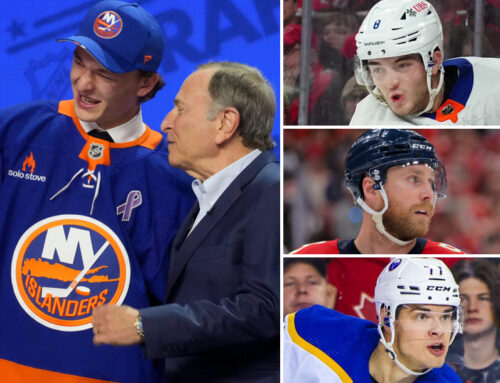
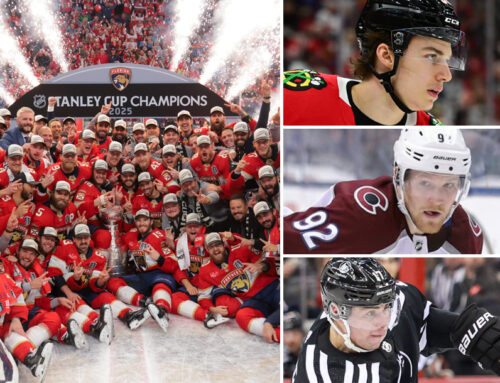
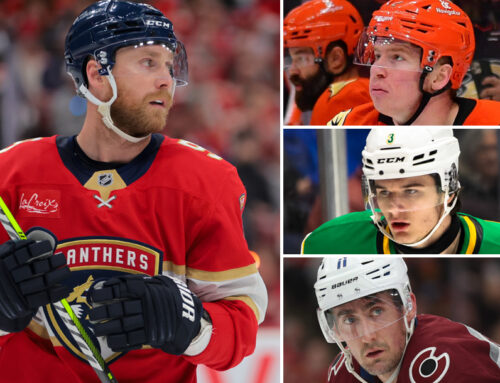
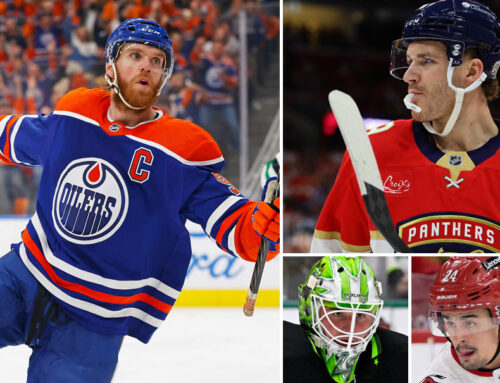
 CAR
CAR MIN
MIN MTL
MTL PHI
PHI
 COL
COL CHI
CHI ANA
ANA WPG
WPG